Types of Mattresses
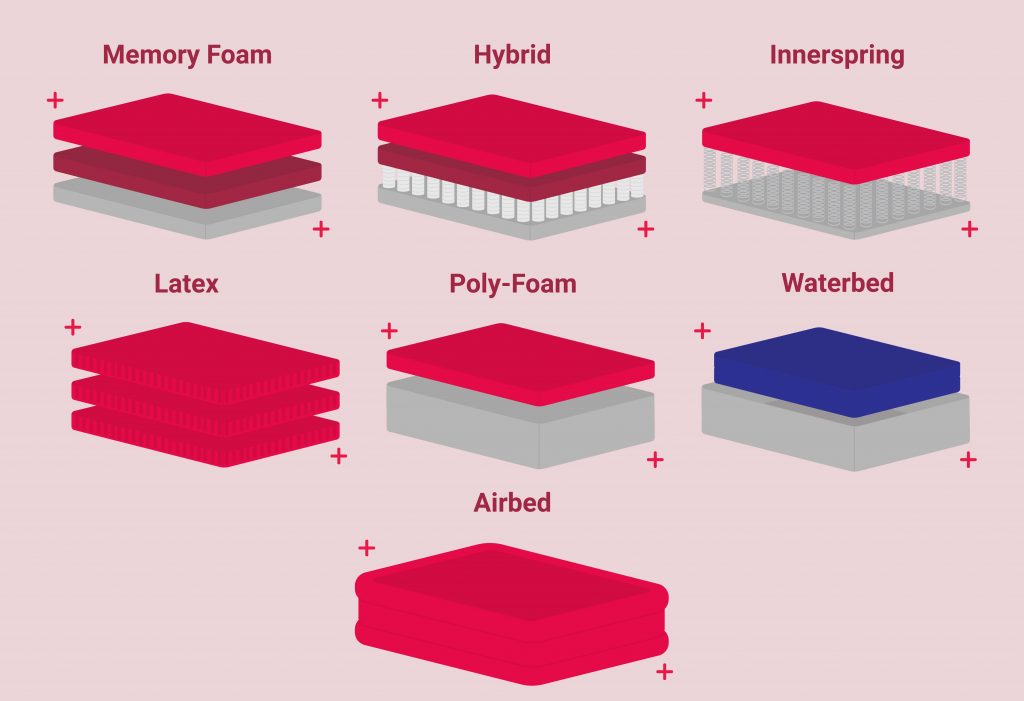
Your mattress has a significant impact on your sleep quality. The wrong type of mattress and firmness level can be the difference between a great night’s sleep or tossing and turning until morning.
The type of mattress you use affects the feel, construction, durability, and most importantly, the cost. The four most common mattress types are memory foam, innerspring, latex, and hybrid, though you may come across the occasional waterbed or airbed.
Knowing what type of mattress you want is the first step to getting a new mattress. So, we’ve summarized the different types of mattresses so know what bed is right for you.
Memory Foam
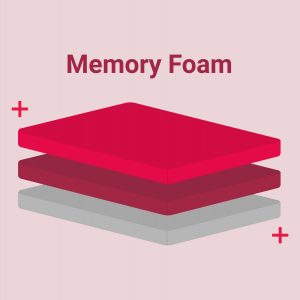 Memory foam is made from something called viscoelastic foam. Memory foam mattresses conform closely to your curves and cradle your body. In a sense, they “remember” your body—hence the name memory foam—and slowly spring back into shape once you move or get out of bed.
Memory foam is made from something called viscoelastic foam. Memory foam mattresses conform closely to your curves and cradle your body. In a sense, they “remember” your body—hence the name memory foam—and slowly spring back into shape once you move or get out of bed.
Memory foam is popular because it’s good at distributing your body weight and thus easing pressure points. It’s a good option for people who struggle with joint pain or body pain. These beds are available in several different firmness levels, so it is easy to find a memory foam bed with the right firmness for you.
Traditional memory foam is petroleum-based, and a common complaint with memory foam is that it traps heat and off-gas. Memory foam gets warm because the material was designed to soften when in contact with heat, and its dense structure is also quite prone to trapping body heat.
Today, memory foam is often infused with cooling materials such as copper, graphite, or gel to offset the heat retention. We suggest searching for CertiPUR-US® certified memory foam mattresses because they don’t contain harsh chemicals and won’t off-gas.
A memory foam bed has a price range between $500 and $1500, and most memory foam beds last roughly 7 to 10 years.
Pros of Memory Foam
- Provides excellent pain and pressure point relief
- Emits little to no noise
- Absorbs motion transfer
- Resistant to allergens and dust mites
Cons of Memory Foam
- Traditional memory foam can trap body heat
- Petroleum-based memory foam is filled with harsh chemicals
- Poor response time
- Softness can cause sleepers to feel trapped
Hybrid
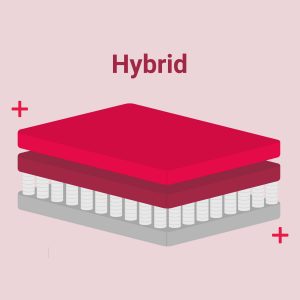 Hybrid mattresses contain pocketed coils and at least three inches of comfort foam, the most common are latex and memory foam hybrids. The coil layer improves air circulation throughout the mattress while the cushioning comfort layers ease pressure points.
Hybrid mattresses contain pocketed coils and at least three inches of comfort foam, the most common are latex and memory foam hybrids. The coil layer improves air circulation throughout the mattress while the cushioning comfort layers ease pressure points.
Unlike a spring mattress—which contains continuous coils—hybrid beds contain individually pocketed steel coils. The coils are not connected, allowing for better support, motion isolation, and edge support. Wrapping the coils in fabric minimizes potential noise from the springs and prevents them from breaking through the mattress.
Rather than a pillow top from cotton or wool, a comfort layer made from foam has less motion transfer and offers more pain relief. Foam is also more durable, so it won’t go flat or soft quickly.
As one of the pricier beds on the list, hybrid mattresses usually cost between $750 to $2500. Still, the average hybrid mattress only lasts 6 to 7 years.
Pros of Hybrids
- Contains positive attributes from foam and standard innerspring mattresses
- Coils allow for air circulation
- Both supportive and pressure-relieving
Cons of Hybrids
- Expensive
- Has a shorter lifespan compared to other mattresses
- Springs potentially produce noise
Innerspring
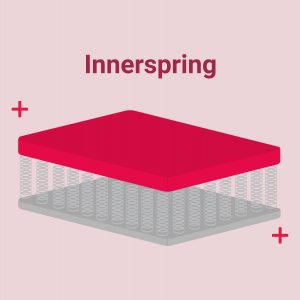 Traditional innerspring mattresses have existed since the 1800s and are still popular today. They contain a continuous steel coil support system (all the coils are connected to each other), while the top layer—a pillow top or Euro top—is made from materials such as foam, cotton, wool, or down. Innerspring mattresses are responsive and cool, but they do sag quickly because of the coil layer.
Traditional innerspring mattresses have existed since the 1800s and are still popular today. They contain a continuous steel coil support system (all the coils are connected to each other), while the top layer—a pillow top or Euro top—is made from materials such as foam, cotton, wool, or down. Innerspring mattresses are responsive and cool, but they do sag quickly because of the coil layer.
Although innerspring mattresses are a popular choice today, they have a low satisfaction rate. The comfort layer is too thin to relieve pressure, and the coils cause a lot of motion transfer and sagging. Innersprings are affordable, but since they don’t last long, they end up costing you more money in the long run.
As far as quality, memory foam, hybrid, and latex mattresses reign supreme compared to innerspring mattresses.
An innerspring mattress can cost anywhere from $100 to $1000 based on the size of the bed. As for its lifespan, an innerspring bed lasts between 5 to 7 years.
Pros of Innersprings
- Naturally cool
- Responsive
- Affordable
Cons of Innersprings
- Pillow top mattresses go flat quickly
- Noisy coils
- Lots of motion transfer
- Minimal pressure relief
Latex
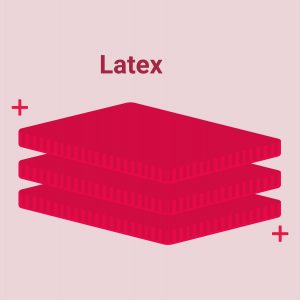 Latex foam is an all-natural mattress option made from the sap of rubber trees. The result is a buoyant, breathable, and pressure-relieving bed. Latex is similar to memory foam in that it contours closely to relieve pressure points.
Latex foam is an all-natural mattress option made from the sap of rubber trees. The result is a buoyant, breathable, and pressure-relieving bed. Latex is similar to memory foam in that it contours closely to relieve pressure points.
Natural mattresses are typically safer for your home as they don’t contain harsh chemicals that can irritate allergies. There are two types of natural latex—Talalay and Dunlop—and the difference between the two lies in the manufacturing process. Dunlop is cheap to produce, firm, and durable, so it’s usually the support foam for latex mattresses. Talalay is soft and breathable, so it makes for a great comfort foam.
Both Dunlop and Talalay latex are natural products and safe for your home. You may come across synthetic and blended latex mattresses, but they aren’t as durable as natural latex and contain harmful chemicals.
Natural latex mattresses can start as low as $700 and go up to $5000 or more. Although they are expensive, natural latex mattresses last 12 to 15 years.
Pros of Latex
- One of the longest-lasting mattress types
- Natural mattress option
- Springy, so sleepers don’t feel stuck in bed
- Naturally cool, preventing overheating at night
Cons of Latex
- Expensive
- May not provide enough pressure relief for some
- Not an option for people with latex allergies
Poly-Foam
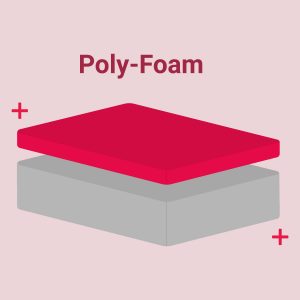 Poly-foam, or polyurethane foam, is a name encompassing many different types of synthetic foams. Many mattress companies develop proprietary blends of poly-foam, allowing brands to offer high-quality mattresses at a reasonable price. These proprietary foams are cool, pressure-relieving, and supportive, like memory foam or latex.
Poly-foam, or polyurethane foam, is a name encompassing many different types of synthetic foams. Many mattress companies develop proprietary blends of poly-foam, allowing brands to offer high-quality mattresses at a reasonable price. These proprietary foams are cool, pressure-relieving, and supportive, like memory foam or latex.
Lots of mattresses only contain poly-foam for certain layers of their mattresses—such as a base or transition layer—rather than making a mattress entirely of poly-foam. Those mattresses often feature latex or memory foam as the comfort layers.
Sometimes, poly-foam can contain potentially harmful chemicals. As with memory foam beds, we recommend looking for a poly-foam mattress that is CertiPUR-US® certified to ensure your bed is safe.
Poly-foam mattresses cost between $100 to $1200 on average. Poly-foam mattresses only last between 6 to 7 years, but modern poly-foam mattresses are becoming increasingly durable.
Pros of Poly-Foam
- Inexpensive
- Durable
- Many brands create high-quality forms of poly-foam
Cons of Poly-Foam
- Certain poly-foams contain harsh chemicals and can off-gas
- Some poly-foam mattresses are cheap and wear down rapidly
- Not always durable compared to other foams
Waterbed
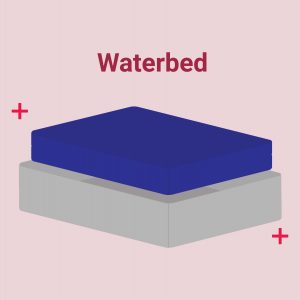 Although waterbeds seem like a relic of the 80s, they’ve existed for thousands of years in different forms. The waterbeds you know today are vinyl mattresses filled with water. Of course, you’re not just resting on a cold vinyl bag. The mattresses have soft mattress covers and look like any regular mattress.
Although waterbeds seem like a relic of the 80s, they’ve existed for thousands of years in different forms. The waterbeds you know today are vinyl mattresses filled with water. Of course, you’re not just resting on a cold vinyl bag. The mattresses have soft mattress covers and look like any regular mattress.
Waterbeds fell out of popularity due to their maintenance needs. The beds are heavy, prone to leaks, and are difficult to fill. While you could technically fill the water chamber outside, which seems more convenient, waterbeds weigh hundreds of pounds once they’re filled.
Although waterbeds aren’t as popular as they once were, they still exist today. Sleeping on a waterbed is therapeutic and pain-relieving. Waterbeds contain heaters, so you can heat or cool the water as needed, a benefit for pain sufferers.
Waterbeds have a wide range of prices, starting as little as $50 up to $2000 or more. While waterbeds can technically last 20 years, they are also prone to breaking, which shortens their lifespan dramatically.
See also waterbed vs air mattresses.
Pros of Waterbed
- Great for pain sufferers
- Sleepers can adjust the temperature of waterbeds with heaters
- Unique mattress design
Cons of Waterbed
- Prone to leakage
- Extremely heavy and difficult to transport
- Waterbed maintenance and installation is a hassle
- Filling a water bed and maintaining the heater can be hard on your bills
Airbed
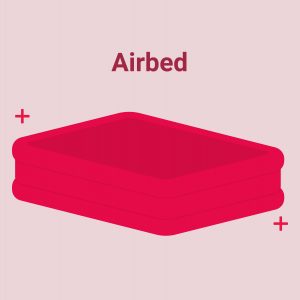 Airbeds are blow-up mattresses, but they’re not all low-quality. Air mattresses are made from polyvinyl chloride (PVC) bags full of air. Still, high-quality air beds look no different than a regular mattress and some even contain foam layers for extra support.
Airbeds are blow-up mattresses, but they’re not all low-quality. Air mattresses are made from polyvinyl chloride (PVC) bags full of air. Still, high-quality air beds look no different than a regular mattress and some even contain foam layers for extra support.
Airbeds became popular because they’re easy to transport and easy to set up—you simply fill the mattress with air when needed and deflate it and tuck it away when it’s not in use. Also, while cheap airbeds are popular when traveling or hosting guests, high-quality air mattresses work well as an everyday bed.
Air mattresses generally cost between $50 to $450 depending on the quality and size of the bed. Most air beds come with an air pump, but if not, a simple air pump costs between $10 to $100. Air beds usually last 5 to 10 years depending on how well you care for them.
Pros of Airbed
- Won’t sag or grow soft
- Easily adjustable
- Hassle-free transporting
- Inexpensive
- A good option for guests or when traveling
Cons of Airbed
- Most air beds on the market are low-quality and cheap
- Provides little in terms of pain relief
- Prone to punctures
- Typically come with short warranties
FAQs
Does memory foam make your back hurt?
Sleeping on a memory foam mattress should not make your back hurt unless you’re on the wrong firmness for your sleeping position. If you are experiencing back pain when sleeping on a memory foam mattress, it’s unlikely due to the type of mattress you have. Rather than the type of mattress, it’s more likely the mattress is the wrong firmness for you—too soft or too firm—sagging, low-quality, overly thin, or paired with an incompatible frame.
Does the type of mattress impact firmness?
No, the type of mattress you have plays no part in its firmness level. Although mattresses have different feels, this isn’t the same as their firmness levels.
All types of mattresses come in a variety of firmnesses ranging from extra-soft to extra-firm. Waterbeds and airbeds don’t come in a variety of firmnesses. Instead, adjusting their firmnesses comes down to the amount of water or air you add to the beds.
What type of mattress is best?
Choosing the best mattress type for you comes down to your personal preferences, so there’s no one best mattress.
The best mattress for you will depend on your budget and what you need from your bed. If you need more bounce and breathability, we suggest looking into a hybrid or latex bed. However, if you want lots of pressure and pain relief, try out a memory foam or latex bed.
What type of mattresses do 5-star hotels use?
Hotels commonly have mattresses custom-made for their rooms. Hotels often feature memory foam mattresses, innerspring mattresses, and hybrid mattresses, but this varies from hotel to hotel.
With this in mind, it’s not just the mattress that makes hotel beds feel so great. They use high-quality bedding, pillows, blankets, and sometimes even plush mattress toppers. At hotels, the staff washes the sheets and blankets between every guest, and they regularly clean the mattress and pillows.
What is an adjustable bed?
Despite their name, adjustable beds are not a mattress themselves, but foundations you rest a mattress upon. They are motorized foundations—often paired with a remote—which allow you to alter the angle of the head and foot of your mattress to elevate your body. Adjustable beds can feature customized presets, USB ports, massage features, and more.
They cost between $400 to $2000 on average. While they are an expensive accessory, they have a multitude of benefits, including relieving pain, promoting natural alignment, reducing sleep apnea symptoms, and more.
Conclusion
Every mattress has unique features and specific firmnesses, so consider your needs and budget when choosing a new bed.
Innerspring, hybrid, and latex mattresses are bouncy and cool, but hybrid and latex beds offer better cushioning and pressure relief than innerspring beds. Memory foam and poly-foam mattresses conform to your body well, though they aren’t very springy. Airbeds and waterbeds are unique and cheap, but they’re not the best mattress option compared to others.
Most mattresses come with sleep trials where you can test a mattress at home and return it if it’s wrong for you. Take advantage of sleep trials if you’re uncertain about what type of bed to choose.
This article is for informational purposes and should not replace advice from your doctor or other medical professional.
Sarah Anderson, Certified Sleep Science Coach 
Sarah Anderson is a sleep, health, and wellness writer and product reviewer. She has written articles on changing and improving your sleep schedule, choosing the right mattress for chronic pain conditions, and finding the best pillow for you. Sarah Anderson has her Bachelor of Arts degree from Arizona State University in Journalism and Mass Communications. Prior to working for Zoma, she wrote for a variety of news publications. Sarah's work has been featured on Bustle, PureWow, and other publications.
View all posts

